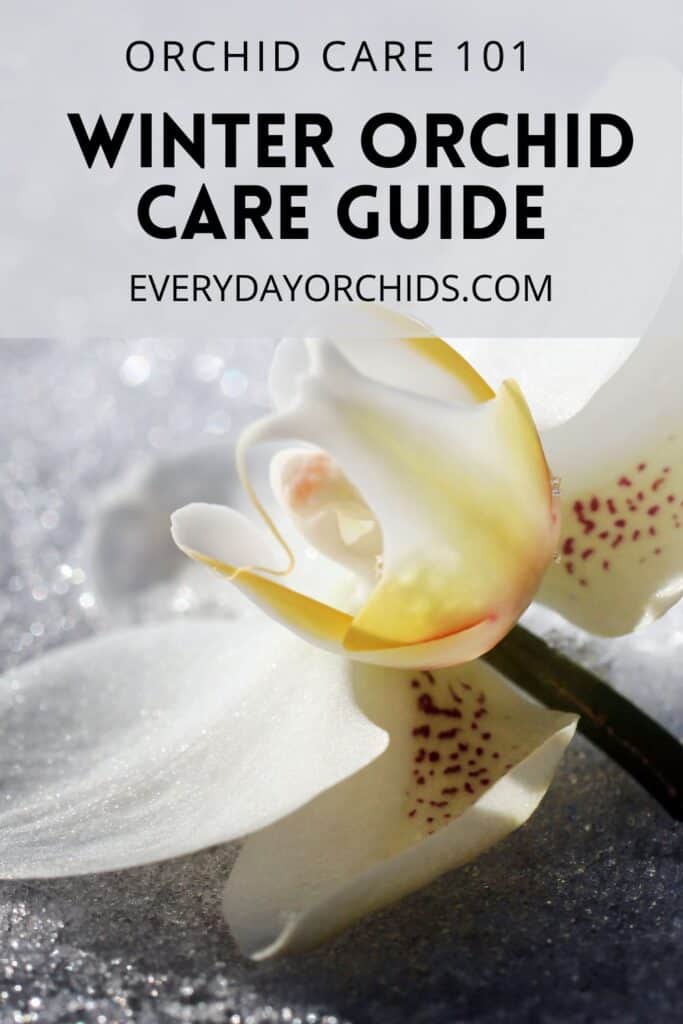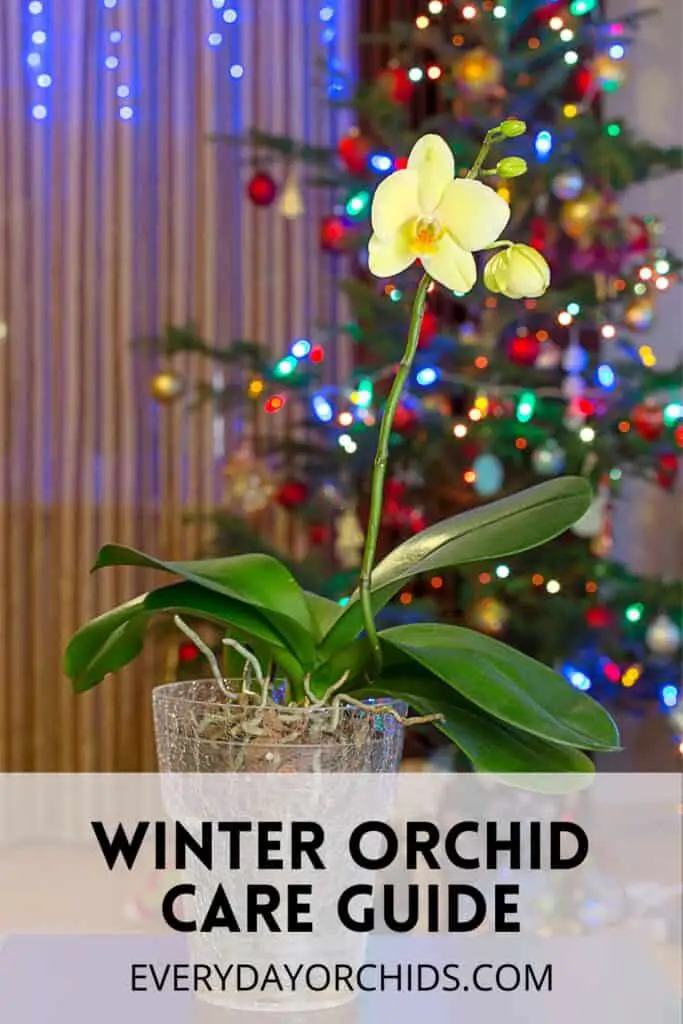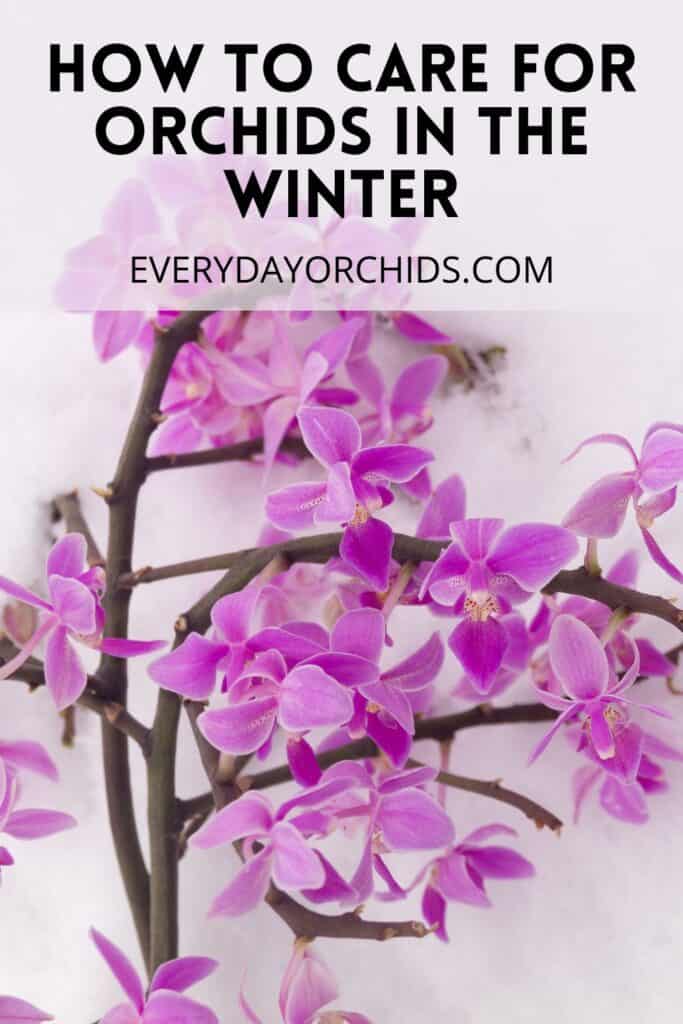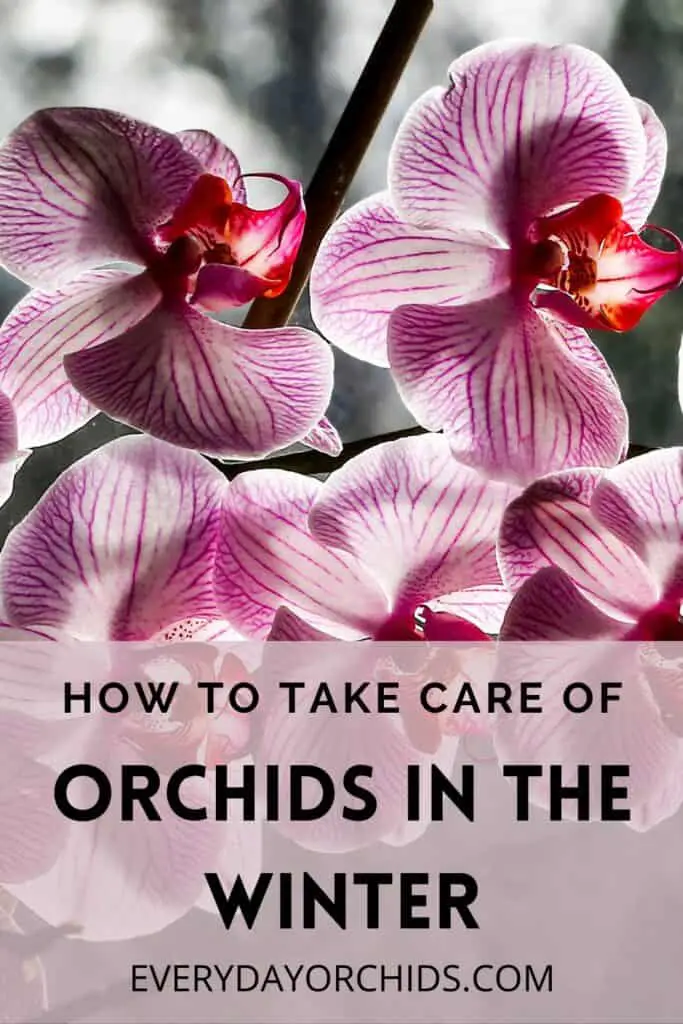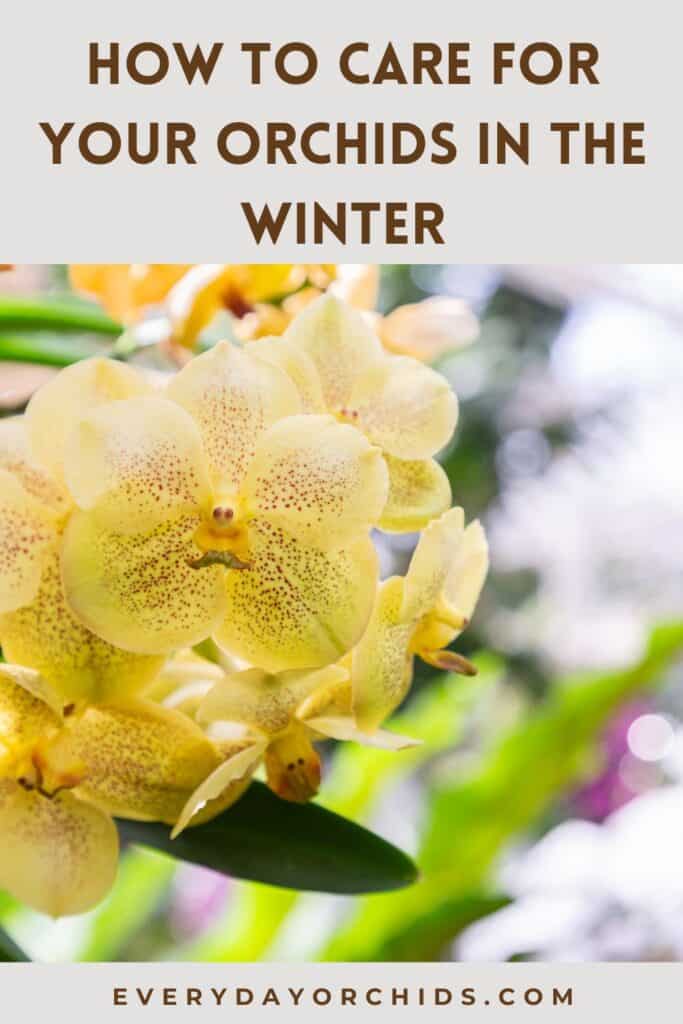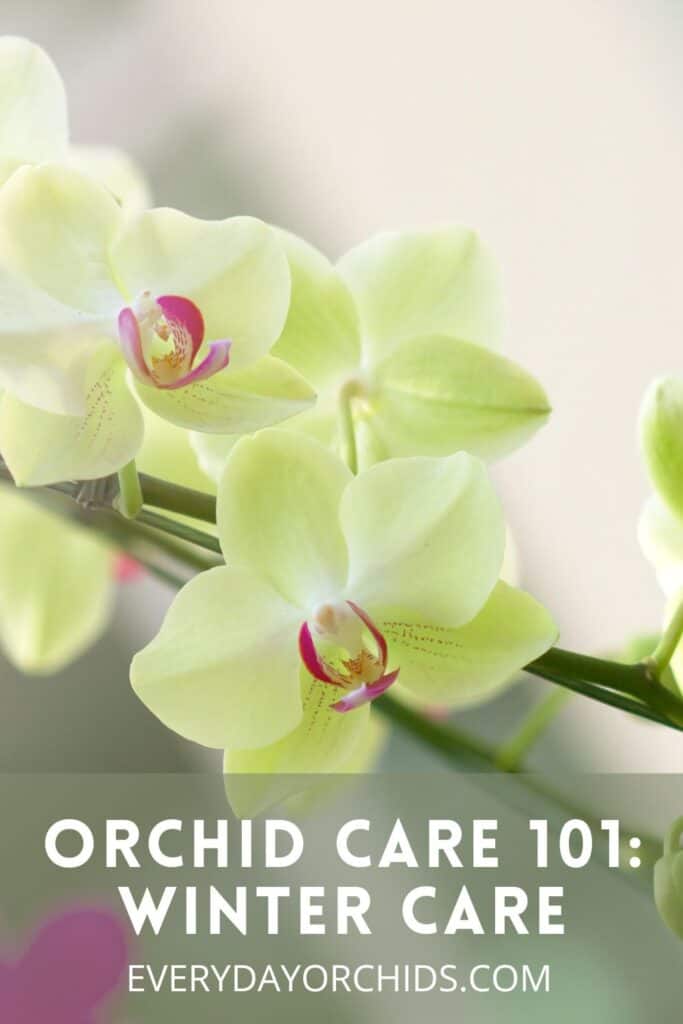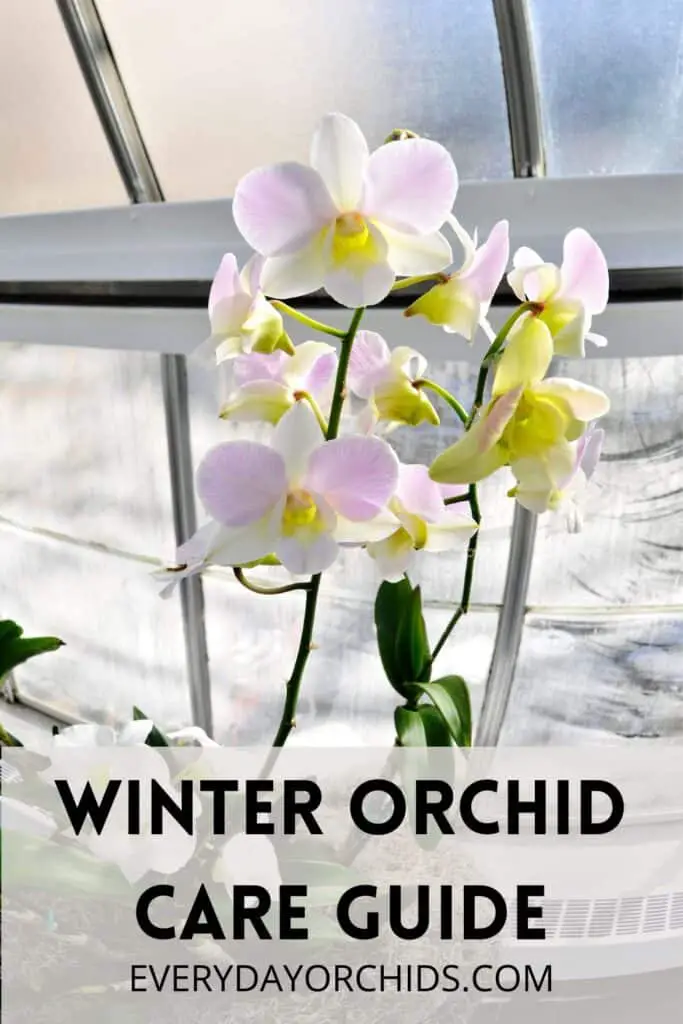Wondering how to care for your orchids in the winter? Proper orchid care in the winter is essential to ensuring your orchids not only survive the cold weather, but also continue to thrive.
When outdoor temperatures plummet into that sub-freezing territory (below 32°F or 0°C), winter in some parts of the world can pose some threats to your orchid’s health. This can include stalled growth, discoloration (browning), and fungal infections.
However, a proper winter orchid care routine can go a long way towards ensuring a swoon-worthy bloom come spring.
To take care of orchids in the winter, bring the plant into a warm, humidified room. Place the orchid in front of a south or east-facing window with indirect sunlight. Water your orchid twice a month and fertilize once a month. In addition, setting up an oscillating fan and artificial lights can support your orchid’s health during the winter.
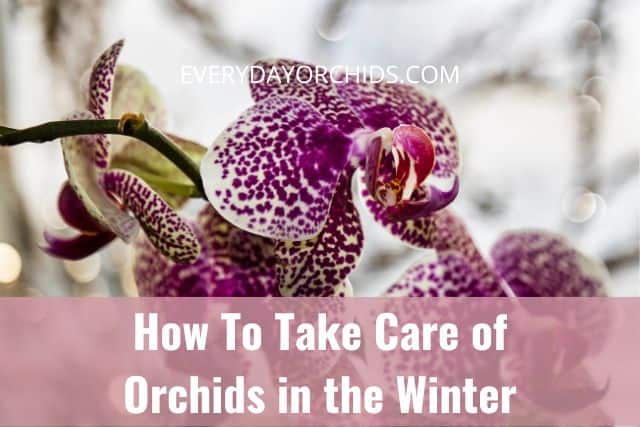
Bringing your beloved orchid indoors or into a temperature-controlled room are often necessary when winter arrives — but not always. To learn about more winter orchid care tips and how to prevent cold and freezing injuries, keep reading!
Note: The information in this article only applies to those orchids who do not need a winter rest. How to care for orchids requiring a winter rest will be covered in a separate Everyday Orchids article.
Please note that these links are affiliate links and as an Amazon Associate, I earn from qualifying purchases. Purchases made through affiliate links in this post may generate commissions at no additional cost to you. Use this link for a discounted Amazon Prime trial. Thank you for your support!
Table of Contents
How To Winterize Orchids
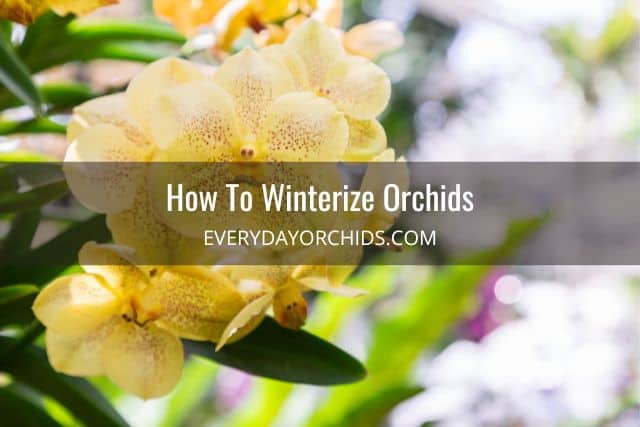
Tropical orchids can tolerate cold snaps surprisingly well. However, three consecutive months of biting cold and blizzard warnings can threaten the much-awaited spring flowering for your orchid.
Winterizing your orchid will protect it from the upcoming chill and frost. It will also help keep your orchid healthy until the spring.
So, how do you prepare your orchids for this coming winter? You can prepare your beloved Cymbidiums, Cattleyas, or other orchids for winter by:
Performing Species-Based Winterization Research
All 25,000+ orchid species (including hybrids) have unique growing conditions. For example, cold-growing species like Cymbidiums produce corsage-worthy spring blooms with 45-55°F (6 -12°C) exposure on winter nights. Cattleyas and other warm-growers may not survive that same temperature drop without undergoing irreversible frost damage or the ever-dreaded fungus.
Proper winterization begins with in-depth research into ideal diurnal (daily) and winter temperatures for your orchid species.
It also helps to do some research before becoming an orchid collector. Compare each orchid species’ ideal environment to your home’s winter and summer conditions.
Select an orchid species that would do well in your climate and would require the least intervention.
Otherwise, winterization measures for your orchids will be an annual, time-consuming, and potentially costly endeavor.
Bringing Your Orchid Inside In The Winter
In the Northeastern United States, the autumn and winter months can be wildly unpredictable. Sometimes, there are 20°F (-6.67°C) fluctuations from one day to the next in some parts of the country. Keep a close eye on the daily low temperatures and looming cold fronts as winter nears. One night in sub-freezing temperatures might not result in browned or necrotic leaves, but nightly exposure certainly can!
If you have a warm garage, spare bathroom, or unoccupied den, bring your orchid inside temporarily and:
- Position it a few inches away from a south or east-facing window. Do not allow the leaves to touch the cold window, as this can trigger cold injury.
- Set-up a space heater and adjust the temperature setting to your orchid’s standards
- Place a cool-mist humidifier nearby if humidity also plummets below 60%.
- Mist your orchid or use a humidifier. Monitor humidity levels with a hygrometer. This will prevent dehydration resulting from low indoor humidity. If moisture is an issue, a steamy bathroom is an excellent alternative.
- Fertilize each orchid once every two weeks rather than once a week to match the slower growth rate during wintertime.
- Water your orchid less often, i.e. once every ten to fourteen days rather than weekly.
I will touch on each of these topics more in-depth later in the article — stay tuned!
If the cold front invades your area quicker than expected, immediate relocation could be necessary. Place your potted orchids into a wagon, milk crate, or cardboard box to bring them inside all at once.
A last-minute tarp or drape will do in a pinch. You can do this if there is a surprise flurry and bringing the plants indoors is not feasible.
Preparing Your Outdoor Orchids for Winter
Lugging your orchids around during the winter months can be stressful for both you and your struggling plants.
If your orchids grow in permanent hanging planters, a home garden, or a heavy ceramic pot, winterizing your orchid takes on a more complex approach. You will need to do the following:
- Avoid watering orchids the night before cold or freezing temperatures. Doing so heightens the risk of frost and freezing and root damage.
- Create an insulating wrap with frost cloth, twine, and clothespins to protect orchids from unexpected wind and cold.
- Apply extra mulch around your orchid’s base for an artificial warming layer. This is especially important for terrestrial orchids that cannot be brought indoors.
Do not assume that living out West or along the Gulf Coast protects your orchids from menacing winter weather. Be prepared to cover or bring your orchid inside when the rare cold front, flurry, or El Niño arrives.
What Is the Ideal Temperature Range for Orchids In The Winter?

Generally speaking, orchids grow best in 50-80°F (10-26°C) temperatures. They can tolerate slight seasonal and daily variations with little trouble.
In fact, most orchid species require a 10-15°F (-12 to 9°C) difference between daytime and nighttime conditions for optimal growth and flowering:
- The 60-90°F (15-32°C) mid-day “heatwave” allows orchids to create more energy (carbohydrates).
- The 50-70°F (10-21°C) nightly “chill” stores this energy to ensure a bountiful spring bloom.
Improper temperature fluctuations will not necessarily cause an orchid to die or rot. However, it might prevent or stall blooming come springtime.
An orchid’s particular temperature requirements depend on the species and its native environment. As such, orchids are either cool-growing, intermediate-growing, or warm-growing.
The table below explains the details behind each classification:
| Type of Orchid | Ideal Day Temperature | Ideal Night Temperature | Sample |
| Cool-Growing | 60-70°F (15-21°C) | 50-55°F (10-12°C) | Dendrobiums |
| Intermediate-Growing | 70-80°F (21-26°C) | 55-65°F (12-18°C) | Cattleyas |
| Warm-Growing | 80-90°F (26-32°C) | 65-70°F (18-21°C) | Phalaenopsis |
There is no one-size-fits-all temperature guide for orchids, as all species react to winter differently.
For example, Dendrobiums Nobile orchids produce more bulbs during the spring after cold exposure (and leaf loss) during the winter. A cold snap might not cause irreversible cold damage to heat-loving Phalaenopsis orchids, but a winter-long chill will almost always cause injury.
Of course, these environmental recommendations are for fully-grown adult plants. Seedlings and young orchids may not tolerate rapid temperature changes as effectively. These orchids might be best suited in an indoor set-up until winter passes.
How Cold Is Too Cold for Orchids In The Winter?
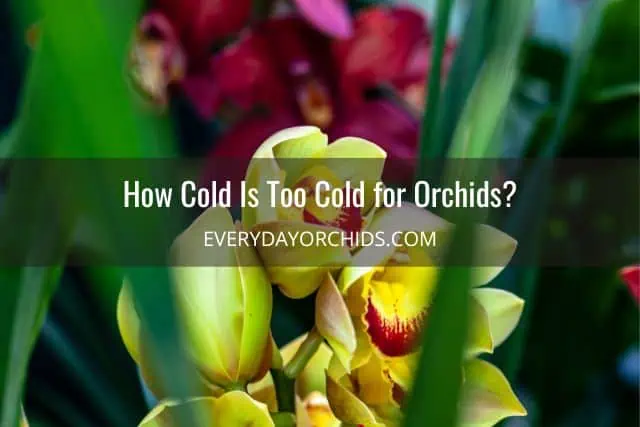
The chart above describes the “ideal” temperature for various orchid classifications. However, a 1-inch snowfall or 30°F (-1°C) nighttime dip is not a guaranteed death sentence.
The most significant cold damage culprits are steadily declining air temperatures and excess moisture build-up (dew) on an orchid’s delicate leaves.
A week long freezing stretch, unexpected cold snap following a drizzle, or a fierce blizzard further amplify the cold damage risk.
When not immediately deadly, long-term cold exposure can trigger these three conditions:
- Cold injury
- Chill injury
- Freeze injury
Any 24 to 48-hour period sitting at 10°F (-12°C) cooler than your species’ “ideal” temperatures can be “too cold” for your beloved plant.
The outlook is far more promising when dew, rain, or snow are noticeably absent.
What Is the Difference Between Orchid Cold Damage/Injuries and Frost Damage/Injuries?

Even the most cold-tolerant orchid species struggle to survive above-freezing temperatures long-term. Your orchid might overcome frost and sub-zero temperature drops without immediate damage. However, it could take days to recognize these often-reversible side effects after complete warming.
Here is a look at how cold damage, chill damage, and frost damage differ. I will also go over how to tell which is impacting your orchid:
Cold Damage/Injury
Cold damage/injury often develops after several repeated days of severe cold exposure. An orchid suffering from cold damage will appear noticeably lifeless or ill, with the most common signs including:
- Limp or lifeless leaves
- Brown or black leaves
- Black or brown pits
- A mildly squishy appearance
If humidity remains high following this brutal winter cold snap, it could take days (or even weeks) to notice the symptoms. This delayed response makes it more challenging to reverse cold injury and return life to your potted orchid, though it is possible.
Chill Damage/Injury
Chill damage/injury occurs with less severe low-temperature exposure but can eventually transition into cold damage if temperatures continue dropping.
However, it is often challenging to diagnose chill damage. The signs are similar to other orchid ailments, such as dehydration or heat stress. An orchid inflicted with chill damage or injury could:
- Appear frail, sunken, or discolored
- Develop leaf browning or blackening
- Begin showing signs of death
- Be more susceptible to infestation or infection
An orchid with chill injury is far more likely to make a full recovery and return with a bountiful bloom in April. This is only possible though, if the injury is recognized and treated in time.
Frost Damage/Injury
Freeze (or frost) damage/injury develops when a cold front strikes as dew or water droplets remain on an orchid’s leaves.
At below-zero temperatures, the water converts into a sheet of ice (or snow-like frost), producing symptoms like:
- Burned leaves or leaves with holes
- Water collection on leaves and wilting (leading to eventual leaf death)
- Severe browning or blackening
- Bacterial or fungal growth
With prolonged leaf soaking, an orchid’s normally-beautiful leaves become a breeding ground for bacteria and fungi. This poses another glaring threat to an orchid’s livelihood.
Can Orchids Recover From Cold Damage/Injuries?

Uncontrollable browning, dying leaves, and stem wilting can all be discouraging after a surprise cold injury battle.
However, orchids can recover from cold damage/injuries to an extent. Their recovery depends on the length of exposure, temperature, and type of damage incurred.
To help your orchid bounce back from dangerous cold exposure, you need to approach this condition quite delicately:
Do a Little Pruning
In nearly all instances of cold or freeze injury, an orchid will suffer from mild to severe tissue damage (necrosis). Carefully pruning the dead tissue and trimming off damaged leaves can reduce bacterial spread throughout the plant.
Use sterilized shears to nip the dying leaf at its base. Then, cover the wound with a dab of fungicide to protect your orchid as it continues healing.
Be cautious about over-pruning or trimming your orchid after a cold injury. Only remove damaged or diseased orchid leaves. Do not pull off any dead tissue that could protect an orchid during the next cold front.
Do Not Overwhelm the Orchid With Stimuli
It is normal to want to “shock” your orchid into growth following prolonged cold exposure. However, you should know that cold-damaged orchids are wildly sensitive to all stimuli.
As soon as you notice cold damage, here is what you need to do:
- Bring your orchid indoors and out of the cold.
- Stop watering your orchid temporarily and allow the soil to dry.
- Turn on a humidifier and adjust the setting to 50-70%.
- Avoid direct heat and sun exposure as your orchid heals.
- Water your orchid once growth finally resumes.
- Sprinkle plant food or fertilizer weekly to nurture further healthy growth. Note: fertilizing too soon can overwhelm a damaged orchid still recovering from the cold.
No matter how frazzled you become after almost losing your orchid, understand that there is no “quick fix” to a cold-damaged plant. It could take weeks to reverse the damage entirely. The outlook is not always grim with proper precautions however!
Treat Rot Immediately
Damaged and dying orchid leaves are even more susceptible to bacterial rot. Store-bought fungicides (or even a DIY cupric hydroxide and mancozeb concoction) can prevent disease spread in an already-weakened orchid. Douse the decay with a fungicide spray, or gently massage it onto the orchid’s leaves with a soft-bristled toothbrush.
What Do Orchids Need During the Cooler Months?

The cooler months can be incredibly hectic as a proud orchid collector. All it takes is one winter storm, cold snap, or excess rainfall to trigger a daunting cold injury diagnosis.
As autumn, winter, and the accompanying briskness and cold air arrive, your orchids will need slight routine adjustments, including:
Temperature Control For Orchids In The Winter
The only way to ensure future flowering is to shield your orchid from below-zero temperatures as often as possible. You can mimic that ideal 10-15°F (-12 to -9°C) night versus day temperature change indoors with these two methods:
- A thermostat and space heater combination: For warm-growing orchids, set a space heater to 75°F / 24°C (or its maximum setting) during daylight hours. Point the heater away from the orchids to avoid heat damage. Turn the heater off after sunset to expose the orchid to your typical nighttime thermostat setting — 65-70°F (15-21°C).
- A daily indoor relocation: For intermediate or cool-growing orchids, set your home’s thermostat to around 60-75℉ (16-21°C) during the day. Move the orchid into a slightly cooler garage or basement in the evening when temperatures do not hit freezing marks.
A digital temperature gauge can take the guesswork out of proper orchid temperature control. Do your best to remain within 10°F (-12°C) of your orchid’s preferred temperature ranges. Remember that this is not an exact science or always possible.
Watering Orchids In The Winter
Even in its native environment, orchid growth notoriously stalls in autumn and winter. You can read more about the seasons of orchid growth here.
During the fall and winter months, an orchid’s air-exposed roots no longer need regular watering due to the risk of saturation or rot when absorption slows.
With that said, your winter watering routine should adjust to feature:
- Orchid potting media that drains well and a layer of sphagnum moss (helps with water retention)
- Always slightly moist orchid potting media
- Watering that does not trickle into the saucer holding the planter. If it does, empty the saucer after watering so the orchid does not sit in standing water for prolonged periods
- Lukewarm water (not cold water)
- Water every 10 days or when the potting media is nearly dry
Pay closer attention to how damp or wet the potting media is rather than to a pre-determined watering schedule.
A humid room can help the soil retain water for much longer. This means that you can water every 10 days or more instead of once a week.
To learn more about proper watering techniques, read this article on how to water your orchid.
Lighting Requirements For Orchids In The Winter
No matter which room your favorite orchid calls “home,” bright, indirect sunlight should always be your first priority.
To make sure your orchid receives its wintertime 12-14 hours of daily sunlight:
- Choose an east-facing or south-facing window sill.
- Install thin window curtains to lessen the leaf burning risk during peak hours.
- Hang thick, insulating curtains to prevent cold drafts during brisk nights.
- Use artificial lighting to amplify daily light exposure on shorter (or overcast) days.
A temperature-controlled greenhouse or attached sunroom can double as an orchid’s wintertime haven, if available! Otherwise, a well-lit window is an orchid’s next-best option.
To learn more, check out this article about how much light your orchid needs each day.
How Often Should You Water Or Fertilize Your Orchid During The Winter?
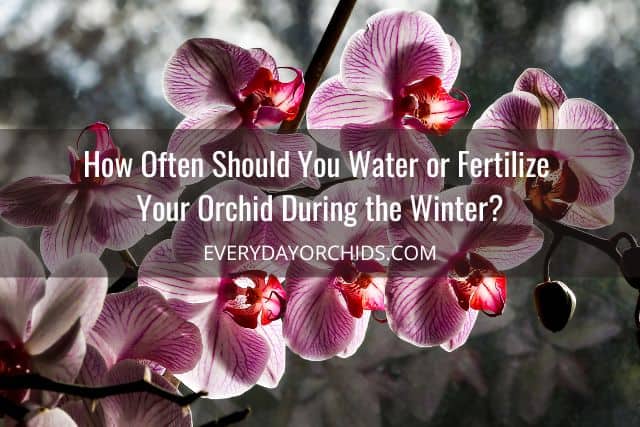
The cold winter weather undoubtedly alters an orchid’s regular watering and fertilizing routine.
Winter is a time for slowed orchid growth, and excess water and fertilizer can do more harm than good.
Here is how often to perform each of these tasks to ensure proper year-round growth:
How Often To Water Orchids In The Winter
Orchids thrive with twice-weekly watering during those dry, summer months when orchid growth is faster.
But come winter, orchids may only require once-a-week or once every other week watering. Even then, only water when the roots feel dry to the touch.
However, orchids without pseudobulbs (those tiny pods that store water), such as Phalaenopsis orchids, will likely still need weekly watering, unless the potting media is still damp.
How Often To Fertilize Orchids In The Winter
If your orchid is one of the rare few that continue growing during those dreary winter months, sticking to your current fertilizing routine is always an option.
But for most orchid species, fertilizing your orchids in the winter can burn and weaken their sensitive roots without nurturing growth!
If you must fertilize your orchid during those chilly winter months, here is what you need to know:
- Apply fertilizer on a bi-weekly or monthly basis (instead of weekly, as you would in the spring and summer).
- Choose fertilizers that are high in potassium and low in nitrate oxygen (10-5-20).
- Transition to bloom booster fertilizer (10-50-10) around late summer to November, with a few sporadic doses until January.
These fertilizer-free winter months allow orchids to recover after three consecutive seasons of growth, flowering, and budding.
No amount of fertilizer will reverse this wintertime dormancy — so give your beloved orchids some much-needed time to rest! If you are looking for more information, check out my article on how to fertilize orchids.
How Much Light Do Orchids Need During Winter?
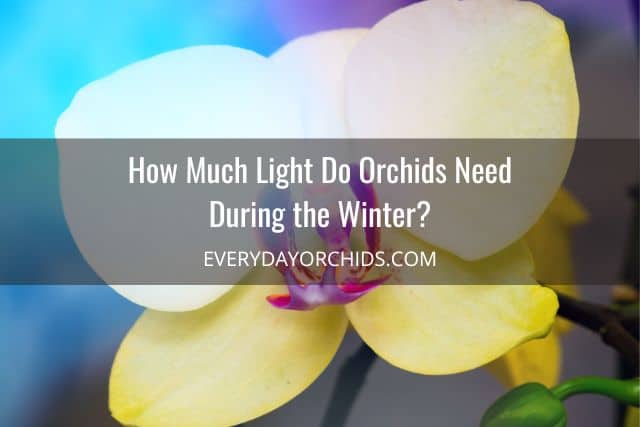
Most orchids require 12-14 hours of indirect sunlight per day during the cold winter months. However, overcast and shorter days could ultimately deprive orchids of sunlight’s essential nutrients. With a successful springtime bloom on the line, you can ensure adequate sunlight by:
Choosing the Right Window
All windows receive sunlight at some point during the day. However, prolonged direct sunlight can burn holes into an orchid’s delicate leaves.
On the flip side, excess shade can leave struggling orchids desperate for nutrients.
East and south-facing windows are the perfect combinations of indirect and nourishing sunlight.
Don’t forget to leave a few inches between your orchid’s leaves and the cold windowpane. This will prevent tissue damage on cold nights.
Setting Up Artificial Lighting
While there is no true equivalent to natural sunlight, artificial lighting is an orchid’s second-best option. You can use this if you live in a windowless apartment or lack south and east-facing windows.
Your winter artificial lighting options include:
- Fluorescent: This cost-effective artificial lighting solution hovers just 3-6” above your orchids, ideal for species with low-light needs.
- High-intensity discharge (HID): These high-powered bulbs nurture both leaf growth and stem height during winter.
- LED: This energy-efficient option suits cool-growing orchids best due to their significant low-heat emissions.
No matter which artificial light solution you decide on, an easy-to-maintain routine is vital.
Connect your light unit to an automatic wall timer, providing uninterrupted sunlight from sunrise to sunset. You can also combine sunlight and artificial alternatives, if necessary.
To choose the proper strength light bulbs, learn about your orchid’s preferred light intensity, and then refer to this table:
| Light Intensity | Foot Candle | Sample Genus |
| Intense | 4,000-5,000 | Vanda |
| Very Bright | 3,000-4,000 | Cattleya |
| Bright | 2,000-3,000 | Brassia |
| Low | 1,000-2,000 | Paphiopedilum |
For more information, check out my guide on artificial lighting and orchids and find out how you can set up artificial lighting for your orchids.
How Do You Keep Orchids Warm In The Winter?

Keeping your orchids happy and healthy during the winter requires proper watering, fertilization, sunlight exposure, and temperature control.
The latter — temperature control — can be quite challenging to accomplish, especially if you have a warm-growing orchid requiring extra care.
To keep your orchids warm as the outdoor temperatures fall, the first thing you need to do is bring them inside.
The following tips can keep your orchids warm, even as the outdoor temperatures drop:
Use A Space Heater
Setting and keeping your home’s thermostat at 75°F (24°C) all winter can feel brutally hot and rack up a $500 (or higher) monthly electric bill.
A portable electric space heater can keep your orchid warm without uncomfortably sweaty nights and unnecessary bill spending.
Put the heater at least a few feet away from your orchid. Ensure that it is not blowing directly onto your plants — otherwise, you risk dehydration, heat damage, and frail leaves.
Dodge The Draft
Drafty windows (and doors), nearby vents, and radiator heating can deliver temperature “shocks” to unsuspecting orchids.
Keeping your orchid warm indoors requires a complete blockage of outdoor airflow. Seal exterior window cracks with caulk.
Position orchids several feet away from blowing air and hang thick curtains to block sneaky window drafts.
Rely On Artificial Lighting
Artificial lighting can double as a sunlight and heat alternative.
High-intensity discharge bulbs can direct artificial heat onto your orchids for temporary warming on a desk or in a bedroom.
Warning: HID bulbs can burn an orchid’s stem or leaves if they are too close or the wattage is too high. Proceed with caution!
Boost Humidity
When 70°F (21°C) or higher is “too hot,” bolstering the humidity around your orchid can temporarily make it feel warmer.
Place a cool-mist humidifier near your orchid and set it to at least 45%. You can monitor humidity levels using a hygrometer. These are relatively inexpensive and are an invaluable tool every orchid grower should have.
Due to the humidity, the room will soon feel a few degrees warmer (though the thermostat disagrees).
Alternatively, you can rest your orchid planters atop a humidity tray. This will increase moisture around your orchid as the water evaporates.
Just make sure you have good airflow around your orchids’ pots. High humidity with poor air circulation often leads to fungal and bacterial growth.
Choose Warmer Rooms
All houses and apartments have noticeably warmer rooms — often the mudroom, steamy bathroom, or a bedroom just above the furnace.
An orchid grows best in naturally warm areas. Place your orchids on a windowsill in one of these already toasty rooms.
Cover Orchids During Cold Snaps
When a cold snap is on the horizon, wrap your outdoor orchid in a sheet, tarp, plastic bag, or burlap. Doing so can create a temperature-controlled micro climate outdoors.
An extra mulch layer can also warm roots during particularly cold conditions. But if you can, bringing your orchids inside as winter nears is the #1 solution.
What Can You Do To Maintain Air Circulation Around Your Orchids In The Winter?
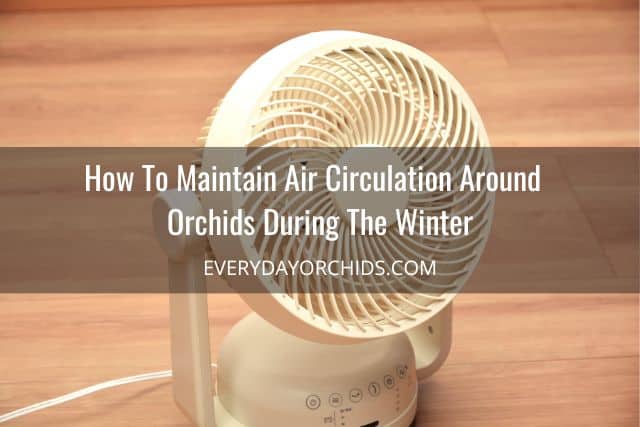
Mimicking your orchid’s native territory is a surefire way to nourish flowering and growth year-round. The long-forgotten solution is proper air circulation, which can prevent common orchid complaints, like:
- Water build-up on leaves (soggy and a bacterial breeding ground)
- Overheating orchids sitting in direct sunlight
- Leaf rot
- Low carbon dioxide levels
- Eventual infection
- Burnt leaves
The best way to keep this room from becoming stuffy, moldy, and stale is with an oscillating or overhead fan on the lowest setting. Put standalone fans across the room to avoid damaging, direct, and drying breezes.
If you have a small orchid collection, you can use a small tabletop fan such as this one. As enticing as opening windows and doors might seem (for fresh air), these sudden temperature spikes can “shock” your orchids.
Final Thoughts
Orchids require year-round care, regular pruning, and close weather monitoring. However, caring for orchids does not have to be stressful, pricey, or time-consuming.
To increase your changes for success, choose orchids that thrive best in your native environment. For example, choose warm-growing orchids if you live in the South or cool-growing orchids if you live in the Northeast.
Always have a back-up plan to protect your orchids from unexpected climate changes. That could mean having a preferred window sill, space heater, insulating curtains, or a wheeled pot ready to go.
When in doubt, bring your orchids indoors when nighttime temperatures remain steadily cold, or winter storms are brewing.
If you enjoyed this article, please pin it and share!
